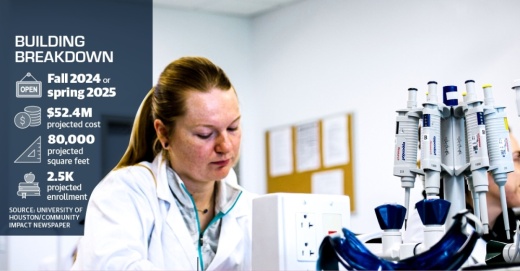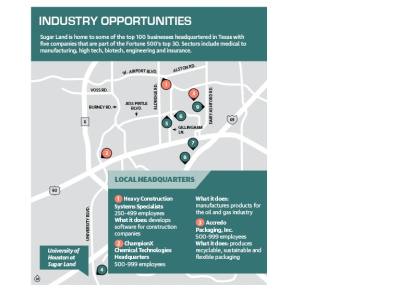The College of Technology is headquartered at UH’s main campus on Calhoun Drive in Houston, but that will change by 2025 when the entire college—along with all departments and programs—will have officially moved its headquarters to the University of Houston at Sugar Land, located at 14000 University Blvd., according to university officials.
With the university eyeing a potential groundbreaking date for spring 2023, a new building will not only provide space for the move, but it will also help to facilitate any future potential growth, said Jay Neal, associate vice president and chief operating officer for UH at Sugar Land.
“Some departments have asked if they can start coming out here and not wait until the new building is on board,” Neal said. “But while we’re happy at the enthusiasm, we have to be operationally realistic.”
UH’s move is a part of its strategy to become a larger part of the Sugar Land and Fort Bend County business infrastructure, Neal said. Adding to the tech workforce pipeline, attracting more businesses and encouraging growth remain top of mind as UH pushes forward with its move, he added.
Ultimately, the college will provide a focal point around education initiatives that are in increased demand and align with local recruitment objectives, said Jeff Wiley, the president of the Fort Bend County Economic Development Council, in an email.
“The move of the College of Technology to our community in its entirety provides an identity that can differentiate us from other communities and education offerings,” Wiley said. "MIT and Cambridge didn’t start with the reputation it has today as a technology hub, but that’s what it has come to represent. If we can capitalize on this educational infrastructure, in 100 years, maybe another community will be saying the same thing about us."
Inside look
In October, the Texas Legislature closed out its third special session of the year by allocating more than $339 million in funding for capital construction projects for the UH System.
Of that, UH was allocated $52.4 million, which will be used to construct the second College of Technology academic building at the Sugar Land campus, Neal said.
The $52.4 million in capital construction assistance projects, paid from the state’s general revenue fund, can only be used for the new building and can not be used to enhance the existing college facilities, Neal said.
“That money as far as I know is earmarked strictly for the building,” Neal said. “These are construction dollars.”
Requests for architectural proposals were sent out in early March with the university expecting to have those proposals in hand by April, Neal said. Many of the building’s details remain malleable, he said.
Construction on a new building will most likely begin at the end of 2022 or early 2023 and open in fall 2024 or spring 2025, Neal said. The building will be located on an adjacent plot of land just southwest of the current College of Technology building.
Meanwhile, the College of Technology has begun moving over its 11 undergraduate majors, 21 undergraduate minors and 12 graduate programs to the Sugar Land campus with a college enrollment of 5,175 students.
For example, the Sugar Land campus will start offering classes in computer information systems, or CIS, and mechanical engineering technology starting this fall, Neal said. In spring 2023, higher-level CIS classes will move over, and by fall 2023, all CIS classes and electives will be held in Sugar Land, according to the university’s website.
College of Technology professor David Crawley said his Information and Technology Department—about 60% of the college—will be moved over by fall 2022.
“There’s a lot of interest in having that close proximity to the community that a smaller campus gives to the program,” he said. “So there’ll be a lot more intimate interaction with the community.”
Beneficial partnerships
When the move is complete, officials hope to be plugged into the Sugar Land and Fort Bend County business communities, Neal said.
“If the city or the county or the [FBEDC] is looking to attract large businesses here, we’ve got that professional workforce pipeline built in,” Neal said.
Included in that pipeline are programs across disciplines, including computing and multimedia, engineering and industrial technologies, health sciences and technology management, per the university’s website.
This comes as the city of Sugar Land reported that its fourth-largest industry sector in 2021 was professional, scientific and technical services. Employment data showed 6,255 individuals, or 8.5% of the city’s workforce, worked in that sector, according to JobsEQ, a software tool that provides workforce and employer data.
The North American Industry Classification System, the standard used by federal statistical agencies in classifying business establishments by type of economic activity, includes architectural, engineering and specialized design services in this classification along with computer services, and scientific research and development.
Fort Bend County follows a similar trend in which the same sector was the fourth largest by employment in 2021 at 35,732 employees, according to data from the FBEDC website.
Both UH and Sugar Land officials acknowledged the College of Technology’s move will economically add to what the Sugar Land campus has already provided.
Between 2018-19, for example, when the university last performed an economic impact study, the campus brought $46.6 million in economic activity to Sugar Land. Professional and technical services made up approximately $1.5 million of that activity, according to the study.
“We’re excited about the workforce that [the] move brings to our businesses and to be able to retain them and give them exposure to our existing businesses is a great pipeline,” said Elizabeth Huff, the city’s economic development director.
That pipeline extends to the Sugar Land Department of Innovation, which uses data, technology and improvement strategies to encourage new ideas and collaboration, per its website. The department’s team partnered with the College of Technology’s leadership and innovation management minor program to provide semester projects for two classes in the program’s spring 2022 introductory Innovation Principles class.
Out of the 148 students enrolled in the class, 52 students are involved in semester projects, which involve creating innovations to address challenges for Sugar Land, Crawley said.
By fall 2022, 185 students are expected to be enrolled in the class.
“This is just our first effort,” Crawley said. “Our plan is to take the whole introductory program ... and address that before the challenges and needs of the city of Sugar Land and the other communities.”
Additionally, Sugar Land’s innovation department has participated in the college’s innovation engineering fast track program, said Reena Varghese, the city’s director of innovation.
“We’re also having the professor come and talk to our organization on the whole concept of innovation and what that means so that we can continue to expand the opportunities that we have both internally and externally with innovation,” she said.
Future growth
Over the last five years, the city of Sugar Land has experienced 2.6% growth in its professional, scientific and technical services sector. That trend looks to continue over the next year with an anticipated 2.8% in job growth, according to JobsEQ data.
Much of the city of Sugar Land has already been built out, Hu said, with plots of land 50,000 square feet or more a rarity.
Still, local businesses have expanded, such as construction software company Heavy Construction Systems Specialists, which has expanded its operations over the last four years, Hu said.
The local expansion comes as the region has also welcomed new tech giants, such as Amazon, which opened two Fort Bend County locations in 2021: a 2.8 million-square-foot fulfillment center in August at 2303 Hurricane Lane, Fresno, and another 3.7 million-square-foot fulfillment center at 10507 Harlem Road, Richmond, which opened in October.
Texas House Rep. Gary Gates, R-Richmond, played a role in the Legislature allocating the funding to UH for the new College of Technology building. Gates represents District 28, which now includes Sugar Land following the state’s redistricting process that was finalized in late October.
The move and expansion by the College of Technology can serve a growing need in the district’s tech industry, Gates said.
“We don’t have a lot of industries that are building plants, but up toward where you have all the industrial—like Amazon, for example—a lot of those jobs are run by a lot of robotics, and it takes a special kind of training to be able to go into that,” he said. “That’s where students coming out of these programs can go into a lot of these other high-tech-type jobs.”
This workforce environment serves as a backdrop for UH as it is in the early stages of also expanding its Sugar Land campus to include a 40-acre industry partnership zone, Neal said. Separate from the College of Technology expansion, the university is working with a consulting firm to generate a strategic plan for the land that should be completed by August.
College of Technology Dean Tony Ambler said the zone will be used to create investment proposals submitted as part of the U.S. Department of Commerce’s Build Back Better initiatives, a program to develop and strengthen regional industry clusters across the country.
This zone will be used to encourage outside investment in the area from industries while also bringing collaboration with the College of Technology and enhancing economic development, Ambler said.
“The new building enables the bulk of the College of Technology to finish its transition to Sugar Land [and] Fort Bend [County],” Ambler said in an email. "This will confirm [the college’s] commitment to economic development in the area with strong links to the educational establishments in the area, as well as with the economic development councils."






